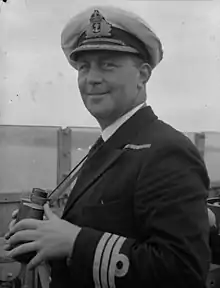Rollo Mainguy
Vice-Admiral Edmond Rollo Mainguy OBE, CD (11 May 1901 – 29 April 1979) was a Canadian Naval officer.
Edmond Rollo Mainguy | |
|---|---|
 Commander E.R. Mainguy, Commanding Officer, HMCS Ottawa, off Botwood, Newfoundland, 22 June 1940. | |
| Born | May 1, 1901 Victoria, British Columbia |
| Died | April 29, 1979 (aged 77) Nanaimo, British Columbia |
| Allegiance | |
| Service/ | |
| Years of service | 1915–1956 |
| Rank | |
| Commands held | Chief of the Naval Staff HMCS Assiniboine HMCS Ottawa HMCS Uganda |
| Battles/wars | Second World War |
| Awards | Officer of the Order of the British Empire Canadian Forces Decoration |
Military career
Mainguy was born in Victoria, British Columbia in 1901 and attended the Royal Naval College of Canada in 1915 during the First World War.[1]
With the start of the Second World War he took command of HMCS Assiniboine and then HMCS Ottawa before being promoted to Captain and taking overall command of Royal Canadian Navy (RCN) destroyers in Halifax in 1941. In 1942 he was appointed acting Commodore and took command of RCN destroyers in Newfoundland, quickly followed by an appointment to Ottawa as Chief of Naval Personnel.[1] He returned to active duty as the commanding officer of HMCS Uganda in 1944. As a part of British Pacific Fleet Uganda took part in the Okinawa campaign.[1][2]
In the post-war years Mainguy was appointed Flag Officer Pacific Coast in 1946, Flag Officer Atlantic Coast in 1948, and was the head of the commission that investigated the RCN insubordination incidents of 1949 before becoming Chief of the Naval Staff in 1951.[1]
He retired from the Royal Canadian Navy in 1956 as a Vice-Admiral.[1] In retirement he was president of Great Lakes Shipping until 1965.[3] He died in 1979.[3]
Family
Mainguy married Maraquita Nichol, daughter of Walter Cameron Nichol, in 1927. Their son, Daniel Mainguy, later also reached the rank of Vice-Admiral, serving as Vice Chief of the Defence Staff from 1983 to 1985.
Awards and decorations
Mainguy's personal awards and decorations include the following:
![]()
![]()
![]()
![]()
![]()
![]()
![]()
![]()
![]()
![]()
![]()
![]()
| Ribbon | Description | Notes |
| Order of the British Empire (OBE) |
| |
| British War Medal |
| |
| Victory Medal (United Kingdom) |
| |
| 1939–1945 Star |
| |
| Atlantic Star |
| |
| Pacific Star |
| |
| Defence Medal (United Kingdom) |
| |
| Canadian Volunteer Service Medal |
| |
| War Medal 1939–1945 with Mentioned in dispatches |
| |
| King George VI Coronation Medal |
| |
| Canadian Forces Decoration (CD) |
| |
| Legion of Merit (United States) |
| |
References
- Awards to the Royal Canadian Navy
- The Uganda Episode Archived 2011-03-15 at the Wayback Machine
- Article in Canadian Encyclopedia
- OBE "For gallantry and distinguished services before the enemy. As commanding officer of a destroyer and as senior officer of convoy escort groups both in the United Kingdom waters and in the North Atlantic, this officer has consistently displayed great powers of leadership and devotion to duty. His example to Destroyer personnel of the Canadian escort forces assisted in no small measure in laying the foundations of the traditions which have since been fostered and upheld by the small ships, which comprise the Royal Canadian Navy."
- "For outstanding zeal, patience and cheerfulness and for never failing to set an example of whole hearted devotion to duty without which the high tradition of the Royal Canadian Navy could not have been upheld."
- "For exceptionally meritorious conduct in the performance of outstanding service as Captain(D), Newfoundland Force at St. John's, Newfoundland in connection with operations with Task Force Twenty-four. His forceful and proficient performance of duty was particularly outstanding and commendable and his intelligent and cooperative attitude toward administrative and maintenance problems concerning the surface forces of Task Force Twenty-four contributed materially to the high state of readiness of those forces. He displayed excellent qualities of leadership and his professional skill and devotion to duty were at all times outstanding."
External links
| Military offices | ||
|---|---|---|
| Preceded by Harold Grant |
Chief of the Naval Staff 1951–1956 |
Succeeded by Harry DeWolf |
